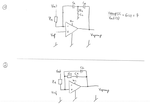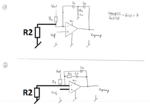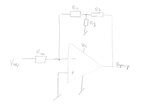al3ko
Junior Member level 3
Dear all
I came across an error amplifier constellation as shown in Figure 1 in the attached graphic. Note how R1/C1 in the local OP-amp feedback is connected to GND. I am more familiar with the more commonly used structure as in Figure 2 in the attached graphic, where R1/C1 is in parallel to the capacitor C2 in the local feedback path. For Figure 2, I can comfortably derive the transfer function.
The goal is to obtain the transfer function Vopamp(s)/Vout(s) of the error amplifier as in Figure 1 in order to properly set the gains of the compensator to stabilize the system. Unfortunately, I am struggeling with it since I am not sure how to account for the GND connection.
Does anyone in this group have an idea on how to deal with R1/C1 when connected to GND when it comes to deriving the transfer function of the error amplifier?
PS:
I am not asking for you to do my job; I would be happy to derive the transfer function on my own, though I would need a little help in the beginning as I don't know how to cope with the R1/C1-GND constellation.
Thank you.

I came across an error amplifier constellation as shown in Figure 1 in the attached graphic. Note how R1/C1 in the local OP-amp feedback is connected to GND. I am more familiar with the more commonly used structure as in Figure 2 in the attached graphic, where R1/C1 is in parallel to the capacitor C2 in the local feedback path. For Figure 2, I can comfortably derive the transfer function.
The goal is to obtain the transfer function Vopamp(s)/Vout(s) of the error amplifier as in Figure 1 in order to properly set the gains of the compensator to stabilize the system. Unfortunately, I am struggeling with it since I am not sure how to account for the GND connection.
Does anyone in this group have an idea on how to deal with R1/C1 when connected to GND when it comes to deriving the transfer function of the error amplifier?
PS:
I am not asking for you to do my job; I would be happy to derive the transfer function on my own, though I would need a little help in the beginning as I don't know how to cope with the R1/C1-GND constellation.
Thank you.


